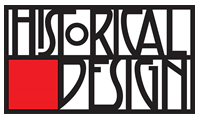Product Description
Wolfgang Kreidl / Max Roesler Jugendstil Keramik “Darmstadt” charger c. 1930


WOLFGANG KREIDL (1906-1972) Dresden, Germany
MAX ROESLER FEINSTEINGUTFABRIK A.G. Germany
“Darmstadt” charger c. 1930
Brown, orange and cream glazed earthenware with a triangle and circle airbrush design, on stand
Marks: Max Roesler Rodach (shield mark), 9, 2925, 6239 1 (under the glaze)
Model illustrated: Keramiken der Neuen Sammlung im Internationalen Keramik-Museum Weiden, Hans Wichmann, (Munich: Staatliches Museum für angewandte Kunst, 1990), cover image and p. 65; Design Contra Art Déco: 1927-1932 Jahrfünft der Wende, Hans Wichman (Munich: Prestel Verlag, 1993), p. 101.
For more information about Wolfgang Kreidel and other models with matching air brush design see: Max Roesler, Keramik zwischen Jugendstil und Art Deco, Rolf Peters (Darmstadt: Museum Künstlerkolonie Darmstadt, 1998), p. 98-102.
Dia: 12 5/8”
Wolfgang Kreidl / Max Roesler Jugendstil Keramik “Darmstadt” charger c. 1930
ANDRÉ THURET (1898-1965) France
“Organic” vase/bowl c. 1930
Handblown and formed clear glass with bubble technique encapsulating a frosty white oxide.
Signed: ANDRÉ THURET
H: 2 3/8″ x D: 4″ x W: 6 1/4″
Andre Thuret was one of the first modern French studio glass artists and a contemporary of Maurice Marinot. He was born on November 3, 1898 in Paris. It is by science that Andre Thuret came to art. It is in Thuret the engineer and the chemist who serve Thuret the vase artist. The scientist places at the disposal of the creator of forms, rates/rhythms and colors the fluid and transparent beauty of glass and the reactions of metallic oxides. He worked in a traditional glass blowing technique at a temperature often exceeding 1,000 degrees. Thuret exhibited at the Salon d’Automne in 1928 and 1932 and obtained his first plate of the Company of Encouragement to Art. He was invited to exhibit in the United States in 1929-1930. Andre Thuret received his Chevalier of the Legion of Honor in 1947.
